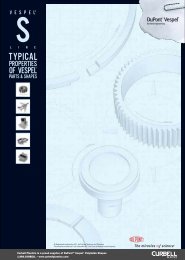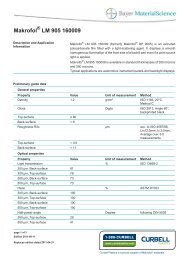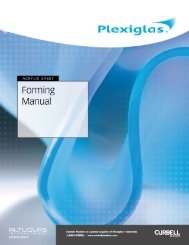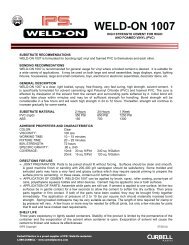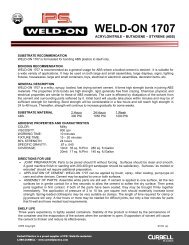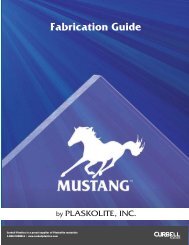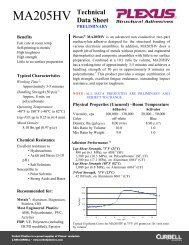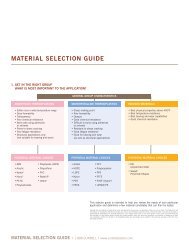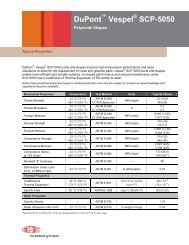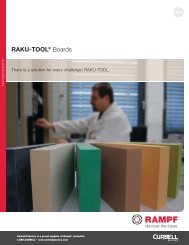Acrylite Acrylic Sheet Fabrication - Curbellplastics.com
Acrylite Acrylic Sheet Fabrication - Curbellplastics.com
Acrylite Acrylic Sheet Fabrication - Curbellplastics.com
- No tags were found...
Create successful ePaper yourself
Turn your PDF publications into a flip-book with our unique Google optimized e-Paper software.
Drilling Large HolesTo drill a hole in ACRYLITE FF sheet greater than 1”(25.4 mm), a circle cutter may be used. The cutter bitmust also be modified to ac<strong>com</strong>modate the materialproperties of acrylic. The tip must scrape the acrylic,not gouge it. For optimum cutting with circle cuttersconsider the following re<strong>com</strong>mendations:· The fly cutter and cutting tool itself must be securedproperly. Cutting tool must only be extended enoughto achieve the desired depth of cut.· ACRYLITE FF sheet must be adequately supportedand clamped to prevent flexing or vibration during thecutting operation. The material should also be placedas close to the fly cutter as possible to reduce thedistance the cutter has to travel.· A spindle speed of between 400-600 rpm isre<strong>com</strong>mended.· A slow, steady feed rate is very important to achievea clean, smooth hole. When the hole has been<strong>com</strong>pleted and the “blank” has freed itself, turning thedrill press off without removing the cutter, is desirablein order to prevent any chipping of the hole duringtool exit.A light misting of water is also re<strong>com</strong>mended to keepthe cutter and plastic cool, and also to act as a cuttinglubricant.For information on the proper cutter bit specificationscontact CYRO Industries, Technical Service at(203)-795-6081.CAUTION: A circle cutter should only be used in a drillpress with the acrylic sheet securely clamped to themachine table. The drill press provides the uniformpressure and constant positioning essential for a safedrilling of quality holes. Never attempt to use a circlecutter with a hand-held electric drill.Drilling - Onsite InstallationsThe previous sections dealt with controlled productionand shop applications. Understanding this information isinvaluable for many hole making requirements. Additionallythere are times that holes need to be made, such asat a job site, where there is limited control of the exactspeeds and feeds that are being used. In these situations,the following bit re<strong>com</strong>mendations may be helpful.Several drill bit geometries are described below that canbe used with success, although most do not leave theinside diameter of the hole with a smooth finish. Thesebits require the same considerations for support behindthe sheet and for cooling as previously reviewed fortwist drills bits.Spade Bit (2" to 1-1/2") - use an advanced designsuch as the Irwin “SPEEDBOR 2000” ® which hasspurs on the outer edges to aid in alignment andprovide smooth break through when the bit exits thematerial.Brad Point Bit (1/8" to 1") - this design is similar toa twist drill with a modified tip similar to a spade bitwith spurs. It has an advantage over a spade bitbecause it has a helical flute design which will pullout chips.Unibit ® or Vari-Bit ® Step Drill (1/8" to 1/2") - thesebits can be used for sheet up to 0.118" (3 mm) thickto achieve a variety of hole diameters with a singlebit. They require maximum support behind the sheetduring use to prevent cracking.Hole Saws w/center pilot drill arbor (3/4" to 6") -these require cooling while cutting to prevent stressbuild up in the sheet. They leave a poor finish on theinside of the hole. They are useful for rough passageholes for installation of HVAC, plumbing or electricalwiring.6



